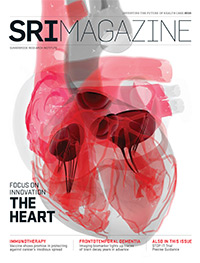Image This!
Canada-wide network aims to improve understanding of vascular disease
June 15, 2015

Dr. Alan Moody is using magnetic resonance imaging to better understand, predict and treat vascular diseases.
In 2007, a group of Canadian imaging researchers decided that they needed to establish a national network that could streamline the process of how images were acquired, stored and analyzed. Such a network could also facilitate large, multicentre studies. Their idea came to fruition with funding from the Canada Foundation for Innovation, Ontario Ministry of Research and Innovation, and the Canadian Institutes of Health Research. Thus the Canadian Atherosclerosis Imaging Network (CAIN) was born.
Atherosclerosis is a disease in which plaque builds up inside the arteries, causing the arteries to narrow and restrict blood flow to the heart and other parts of the body. It is the underlying cause of many vascular diseases of the brain and heart, which commonly manifest as stroke and heart attack, respectively. The focus of CAIN is on atherosclerosis in the carotid arteries leading to the brain and in the coronary arteries leading to the heart.
The network brings together atherosclerosis imaging experts from across the country. It comprises imaging and recruiting sites located in all major Canadian cities. After patients are recruited and undergo imaging such as magnetic resonance imaging (MRI) or computed tomography at qualified sites, their images are sent to a core site for analysis.
Drawing on the expertise of its members, the core sites are categorized by anatomy and spread across academic institutions and research hospitals. Sunnybrook Research Institute (SRI), with its strong track record of imaging and brain research, is home to two core sites. Dr. Alan Moody, head of the vascular biology imaging group at SRI, leads the core site for carotid artery imaging. Dr. Sandra Black, director of the Hurvitz Brain Sciences Research Program, heads the brain imaging site.
Three main goals drive research at CAIN: to understand better the vascular biology of atherosclerotic plaque; to develop and assess vascular imaging technology; and to translate these findings into clinical practice. To address the first goal, Moody is leading a project aimed at using MRI to study plaque biology and neurovascular disease. Specifically, he is testing whether MRI can be used to characterize plaque in the carotid artery and predict clinical outcomes.
A total of 420 patients were recruited from across Canada for the study and underwent MRI scanning to determine their baseline vascular health. The study is now in the follow-up phase, where patients will be followed for two years and undergo an MRI scan each year to track changes in their carotid arteries.
At the same time, researchers will also obtain high-resolution brain images for each patient to see if changes in the carotid arteries are associated with changes in brain structure. One feature they will be looking for is white matter degeneration, which is present in more than one-half of the population aged over 60 years and associated with cognitive decline and dementia.
“I want to see what silent events are happening in the brain,” says Moody, who is also chair of the department of medical imaging at the University of Toronto. “We have this cohort of 420 people with three sets of carotid MR images that we can analyze to see if their white matter is changing, if their carotid is changing and if their [neurovascular] outcome is correlated with these changes.”
The research and infrastructure network established under CAIN provides a framework for larger studies such as the Canadian Alliance for Healthy Hearts and Minds (CAHHM), a national study that seeks to understand the influence of social, environmental and circumstantial factors on cardiovascular disease. The goal of the alliance is to use MRI to image 9,700 people recruited from 30 sites spanning Canada’s diverse geographic and ethnic landscape. The study will include participants from high-risk ethnic groups, including South Asians, East Asians and Aboriginal Peoples living on reserves. To reach those living in remote locations, the researchers retrofitted a bus with an MRI scanner.
For the CAHHM study, which is in the recruiting phase, SRI will serve as the core processing site for MR images of the carotid arteries and brain. Moody and Black will be leading the teams. Moody is also responsible for creating a central repository into which all the images from different sites will be deposited. To that end, a digital research network was recently installed at SRI to facilitate data transfer between core sites.
Through the collaborative effort of a large multidisciplinary team, Moody and his colleagues hope to tease apart the individual effects of geographic and ethnic factors on cardiovascular health. Their findings will help to inform policies and guidelines to optimize health care access and treatment for at-risk individuals, and lower the burden of cardiovascular disease.
Read more about Moody’s research on using MRI to detect intraplaque hemorrhage in Vascular Vulnerability in the 2015 SRI Magazine.



